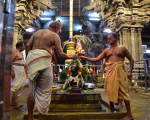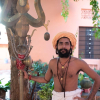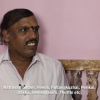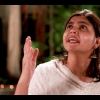Rituals in Tamil Nadu temples become moments of sensuous encounter with the divine. For Tevaram poets, as observed by Indira Peterson (1991, p. 44), ritual is beautiful, an enactment of offering and service that is central to Bhakti, and which creates the community of worshippers. A common perception is that Bhakti, the melting (urugi) of the soul evoked by Manikkavacakar, cannot be contained by ritual, or karya-kand, and is indeed precluded by going through the motions mechanically. Yet performing or participating in ceremonies can embody a unique experience of the sacred, of which a photo essay can convey but a glimpse.
This essay also attempts to offer a perspective on the historical development of rituals. Its title evokes the process of drawing closer to the deity, and simultaneously echoes the title of a recent study of Tamil Srivaisnavism (Jagannathan 2015), that traces larger historical processes wherein scripture and sectarian identity were consolidated by knitting together Sanskrit and Tamil traditions, making for both continuity and change in interpretation. In the case of Saiva rituals, it has been argued that Saivas were responding to the prescription of practices like devapuja (worship of tirthankaras), guru-upasti (worship of teachers), tapas (austerities) and dana (charity) in the Jain community (Prentiss 1999, pp. 69–71). Processes of mutual influence must be excavated from beneath hymns and hagiographies where inter-sectarian disagreement is often on the grounds of ritual practice, be it austerities (Tirumurai 5.58.1–10, cited in Prentiss 1999, p. 73) or extravagance (see Image 6 below).
Rangaswamy evokes how temples in Tamil Nadu grew in 'ever enlarging circles' with each generation, from the garbha griha (sanctum), to the pillared corridors with shrines to deities like Ganesa and Candesvara, to the prakarams where Puranas were expounded, to the gopurams visible to pilgrims from every direction (1958, pp. 11). He cites Appar's verses saying a town where there is no thirukkoyil (temple) or pala talikal (mathas where pilgrims could perform private worship) are no better than a wilderness (Thirumurai 6.95.5), and the inscription celebrating the vicitracitta ('remarkable mind') of the king who built the first rock-cut temple. This is said to be Mahendravarman I (580–630 CE), whom tradition identifies with the king who became Appar's follower according to the Periyapuranam (Rangaswamy 1958, p. 10, Prentiss 1999, p. 81).
Subsequent scholars have noted there are antecedents in the Gupta period for puja-snapana-kusuma-gandha-dhupa-dipa-havir-upahara-bali-samkha-patahadi ('veneration, bathing, flowers, perfume, incense, lamps, food offerings, Bali, conches, drums', see Gollner 2021, p. 94). Michael Gollner further discusses how, from the 12th century, there emerges the distinction between pararthapuja and atmarthapuja (public and individual worship; Gollner 2021, pp. 96–99)
Rangaswamy argues that Sambandar's hymns were meant to be sung in temples, for they evoke places more precisely than Appar's contemplative verse. Yet the more extensive cataloguing of places by Appar might suggest new temples were coming up at the time (Rangaswamy 1958, p. 17). More recent analyses point to how it was the meaning of sites whose contours expanded and shifted over the centuries, and with the consolidation of canons. Leslie Orr contrasts how the 'Tevaram poems create an interior devotional realm, the Periyapuranam a social geography oriented around the saints and community of devotees', and the temple inscriptions fix in place the saints and Siva (Orr 2014, p. 215). Charlotte Schmid observes that the Periyapuranam refers to the Tevaram poets visiting sites that their hymns themselves never mention, and suggests we read the work less as a record of what was than as a 'virtual pilgrimage', that gave 'a sense, a meaning and a direction' to the numerous Saiva sites in existence in the 12th century (Schmid 2014, p. 278).
References
Cutler, Norman E. Songs of Experience: The Poetics of Tamil Devotion. Bloomington and Indianapolis, 2007.
Ellappa Navalar. ‘Arunachala Puranam’: The Tamil sthala Purana of Tiruvannamalai, composed by Saiva Ellappa Navalar, translated by Robert Butler. Tiruvannamalai: Sri Ramanasramam, 2012.
Ganesan, T. 'Sanskrit and Tamil in the Service of Saivism'. In Passages: Relationships between Tamil and Sanskrit, edited by Kannan M. and Jennifer Clare. Pondicherry: Institut Français de Pondichéry, 2009, pp. 163–69.
———. ‘Two Śaiva Teachers of the Sixteenth Century: Nigamajn̄ana I and His Disciple Nigamajñana II.’ Pondicherry: Institut Français de Pondichéry, 2009.
Ghose, Rajeswari. The Lord of Arur: The Tyagaraja Cult in Tamilnadu: A Study in Conflict and Accommodation. Delhi: Motilal Banarsidass Publishers, 1996.
Gollner, Michael A. ‘The Descent of Scripture: A History of the Kamikagama.’ PhD thesis, School of Religious Studies, 2021.
Granoff, Phyllis. ‘Defining Sacred Place: Contest, Compromise, and Priestly Control in Some Mahatmya Texts, Annals of the Bhandarkar Oriental Research Institute 79, no. 1/4 (1996): 1–27.
Jagannathan, Bharati. Approaching the Divine: The Integration of Alvar Bhakti in Srivaisnavism. New Delhi: Primus Books, 2014.
Kalidos, Raju. 'Urdhvatandavam in the Art of South India'. East and West 46, no. 3/4 (1996): 371–413.
Loud, John A. Rituals of Chidambaram. Chennai: Institute of Asian Studies, 2004.
Orr, Leslie C. 'The Sacred Landscape of Tamil Śaivism: Plotting Place in the Realm of Devotion.' In Mapping the Chronology of Bhakti: Milestones, Stepping Stones, and Stumbling Stones, edited by Valérie Gillet. Pondicherry: Institut Français de Pondichéry, 2014, pp. 189–219.
Nagamma, Suri. Letters from Sri Ramanasramam. Volumes I & II, translated by D.S. Sastri. Tiruvannamalai: Sri Ramanasramam, 2006.
Peterson, Indira. Poems to Siva: The Hymns of the Tamil Saints. Delhi: Motilal Banarsidass Publishers, 1991.
Pillai, J. Nallaswami. 'Flower and Fragrance: A Floral Wreath.' n.d. https://shaivam.org/scripture/English-Articles/1301/flower-and-fragrance
Prentiss, Karen Pechilis. The Embodiment of Bhakti. New York: Oxford University Press, 1999.
Rangaswamy, M.A. Dorai. The Religion and Philosophy of the Tevaram, Book I (Volumes I & II). Madras: University of Madras, 1958.
Schmid, Charlotte. 'The Edifice of Bhakti: Towards an 'Archaeological' reading of Tevaram and Periyapuranam.' In Mapping the Chronology of Bhakti: Milestones, Stepping Stones, and Stumbling Stones, edited by Valérie Gillet. Pondicherry: Institut Français de Pondichéry, 2014, pp. 241–286.
Shastri, J.L. ed. Sivapurana, vol. 1. Delhi: Motilal Banarsidass, 1970.
Smith, David. The Dance of Siva: Religion, Art and Poetry in South India. Cambridge: Cambridge University Press, 1996.
Wenta, Aleksandra. ‘The Great Ārdrā Darśanam Festival: Performing Śaiva Ritual Texts in Contemporary Chidambaram.’ International Journal of Hindu Studies 17, no. 3 (2013), pp. 371–98.
Sahapedia is grateful to Bajaj Autos Pvt. Ltd. for the grant that made possible the documentation for this photo essay.
















